Ringing the changes at The Belfry
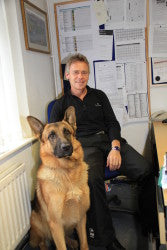
Now under new American ownership, and with a new 'ish' Director of Golf at the helm, our editor headed off to the rural east of Birmingham to catch up with developments
Having hosted the Ryder Cup four times - the most by any course in the competition's long history, either in Europe or the States - The Belfry, and especially the Brabazon course, is held in high regard by devotees of golf, many clamouring to test out their skills across its fifty-four holes.
It is unlikely that any will be able to match a young and fearless Sergio Garcia's now legendary tee shot to the green, over trees and water on the 301 yard, par 4 10th, during the 2002 Ryder Cup; the last time the competition was held there. Simply to play the course is an experience to remember.
The venue's two other courses, the PGA National and The Derby, complete the golf offering and, coupled with impressive leisure and hotel facilities, provide a complete experience.

The resort is being managed for KSL by a subsidiary of the De Vere Group, and it is the De Vere connection that assisted Angus Macleod in being appointed the new Director of Golf courses and Grounds, but not without a slight delay in proceedings.
When the previous Director of Golf, Kenny Mackay, left to take up a similar position at Wentworth, Angus, who was then working at De Vere Belton Woods, a 45-hole golf resort in Lincolnshire, saw the advert on the BIGGA website and duly applied.
"I'd been at Belton Woods for six years and was ready for a new challenge," explains Angus. "Previous to that, I'd spent twelve years as Course Manager at Newport Golf Club in South Wales, so I knew I had the required experience. I had no expectations; I just thought I would give it a go. I was already running a large resort and The Belfry was the obvious step-up."

"A few months later, I got news of The Belfry being bought by KSL, and that DeVere had been chosen as the management company. Not long after, whilst on holiday in Scotland, I got a call asking if I would be interested in running it. I didn't have to think twice about it and accepted immediately. A few days later, I was invited to The Belfry to meet the new owners."
"Kenny Mackay left in February/March 2012, leaving it in the capable hands of his assistant, Jamie Brookes, and I started in August 2012. I still pinch myself, because I can't believe I'm actually here!"
"We have an excellent relationship with KSL. They come over regularly to see how things are going. We have regular board meetings and conference calls. I also deal a lot with ClubCorp, who are owned by KSL, and have a huge wealth of experience in the golf industry. They have an agronomist, Doug Miller from the USA, who comes over and supports us with agronomy, budget and capital requests."

"There is never a dull day here. On my very first day, it was the Ryder Cup selection for 2012 in the USA so, because of our history, we had a camera crew from Sky Sports filming the longest drive champion, Joe Miller, trying to drive the 18th green from the championship tees.
Unfortunately, the prevailing wind picked up and he was falling short into the lake, The producer asked him if he could drive the famous 311 yard, par 4 10th with a putter. He said 'I'll give it a go', which he duly did! Welcome to The Belfry!"

"I always look for good qualities in people and try and promote from within. We need to give them an opportunity which, in return, creates a culture within the department for staff to perform and show their skills in order to progress. If they see someone from the department being promoted, it encourages them and lifts the team. This has been evident with my appointment of Jamie as my number 2. We had confidence in his abilities and he has proven his appointment. All the team have worked really well and I'm immensely proud of them."
With Angus now settled into his role, he has begun his programme of improvements. "We have got a good relationship with KSL in terms of support and budgets," he explains. "Their vision is fantastic; they have a number of large resorts in US and have an eye for detail and know what works, and I'm excited to be a part of the future here. The hotel is currently undergoing a complete refurbishment and, once it is complete, The Belfry will be an outstanding resort."
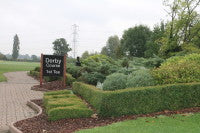
"We have had a 10% increase in golf this year, which is really significant," says a delighted Angus. "But pace of play is becoming an issue and, to help overcome this, we have opened up the PGA course by redefining the rough and fairways, which has made it less 'claustrophobic'. We had to make it a more enjoyable experience."
The increase in rounds has, though, had an affect on agronomy. "It's our biggest challenge trying to get the work done," explains Angus. "Trying to get a good sound agronomic programme is very difficult. Unfortunately, you can't please everyone; we are doing some renovations at the moment and, even though we align the price point, we are bound to upset visitors, because it's 'their' day. Of course, we are sympathetic to their needs and do the work with the least amount of disruption possible."

"We've recently bought two Sisis slitters - one for the fairways and one for the greens. We also have a new Toro Procore SR70 for the fairways, I am a big fan. We secured some capital to spend on new equipment. Our aeration work will now be done on a little and often regime and in double quick time."
Angus goes on to explain that staffing levels are "stable at the moment," and that was always going to be one of his biggest challenges.
"We have taken on a number of apprentices, who we will review at the end of year one and offer an education programme if this is the career path they want."
"I am a huge fan of ongoing training. I love the training side of greenkeeping. We encourage the team to ask me questions and challenge decisions; some do, some are probably a little too scared! I remember, when I was a fifteen year old apprentice, I used to ask questions and got regular clips round the ear for asking 'stupid questions'. That mindset has to change. I keep saying to the lads, don't be scared to come forward, the door is always open, If you have any questions, technical or otherwise, please don't hesitate."
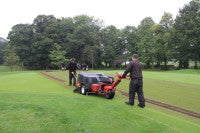
"We've started to introduce compost tea. I like the biology. I like the idea of doing something good. I had some pretty good success with it at my previous place. Dan Clarke, my deputy, is in charge of the brewing. One of our guest speakers explained the theory and offered training for the lads. We have been using it on some greens and approaches. It doesn't cost a lot, just takes a bit of time to brew, but the results have been encouraging so far."
"I believe we have a responsibility to reduce our chemicals and fertiliser inputs. Golf courses used to get bad press, but the industry is slowly changing and we are becoming more sensitive to our environment and we are being challenged to manage our natural resources more efficiently."

Green management is one that Angus is keen to continue. "We have a compound, so that all our cores and anything else compostable can be recycled. We mix leaf litter and cores and use it to mulch beds, borders and hanging baskets. All waste water is treated and fed into our reservoirs where we have Otterbine pumps aerifiying, which is used for irrigation."
"We also have our own bees; Dan Clarke and Terry Jessef are our beekeepers. We had two yields last summer providing over seventeen kilos of honey from two hives. Eddie Ainsworth, the Head Greenkeeper from the Avro Golf Club in Cheshire, gave us some advice. He is a really

"We have started looking at areas of the PGA course where we might introduce wildflower mixes, gorse and whins, and are also considering adopting Syngenta's Operation Pollinator. One of our senior greenkeepers, Matt Whittock, is really passionate about ecology and he has been making bird boxes in his own time and putting them out on the course."
"This winter, we are focusing on the Derby course. We plan to give this small but challenging course its own identity.

"So, as you can probably tell, it's been a very busy time, but it's been good. Following in the footsteps of Kenny Mackay was always going to be a challenge. People are always going to come into a golf course and manage it differently to their predecessor and put their little twist on the courses, and that's the reason it is so exciting. I'm very lucky in that I have good friends in the industry who give me advice and support when I need it."
After concluding my interview with Angus, I met up with my host for the day, Head Mechanic, Chris Minton. He commandeered a golf buggy and we set off for a quick tour of the three courses.
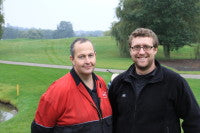
an has been at The Belfry for two years. He was trained at Myerscough and gained industry experience working on golf courses in the United States and at the All England Tennis Club at Wimbledon.
Several greenkeeping staff were on hand to help clean up the cores. The greens were then lightly topdressed with Chelmsford 28 sand and d
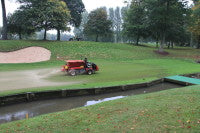
In charge of the topdressing was Jamie Brookes, the Deputy Course Manager, who oversees the work on all three courses. Jamie is one of the longest serving members of the greenkeeping team, having been at the club over twelve years.
In total there are forty-five grounds staff, including gardeners, mechanics and irrigation specialists, with a total of thirty-eight greenkeepers maintaining the three courses. Each course has a dedicated Head Greenkeeper.

Water is sourced from two large reservoirs. The Brabazon has irrigation for greens, tees, fairways, some rough and approaches, whereas the PGA has irrigation for greens, tees and fairways, whilst the Derby only has irrigation to tees and greens. The systems are calibrated on a regular basis, with ongoing repairs and maintenance being undertaken throughout the year.
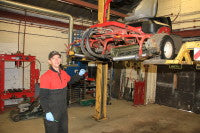
No wonder, I thought to myself, that Angus needs such a well trained and dedicated team of staff to undertake all this work.
Of course, all this work would not be achieved if it was not for the major investment in machinery. I was staggered to see the sheer amount of equipment the team has at its disposal

A lot of the mowing equipment is several years old but, due to the attention it gets - regular servicing, oil, filter changes and maintenance of the cutting units - remains very reliable.
"I'm a stickler for keeping machinery clean and serviced; every member of staff is trained on the use and maintenance requirements for each piece of machinery they operate. Every machine has its own log book which records the hours operated, the dates of any service or repairs and details the work undertaken - for the life of the machine."

As with any golf course, the most costly assets are its machinery and labour, one does not go without the other; having reliable machinery and some highly trained staff is the key to running a golf course.
Chris is very mindful of this and he recognises the value of the work he and his team do to support his work colleagues.
As Angus stated in his interview, the importance of developing staff via good training, and the importance of building a team that supports one another and buys into each other's strengths, skills and experiences, helps to provide a strong affinity within the team, which all go to make the job, for everyone, so much more rewarding.
